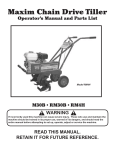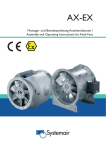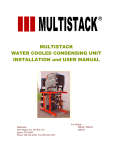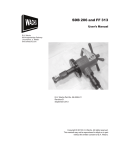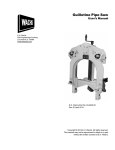Download Maxim MXR500 Operator`s manual
Transcript
Limited Warranty Maxim Manufacturing Corporation, through its dealers will repair or replace any part, or parts of the MS50B, MS30B, or MS50BR or handles that are defective in material or workmanship or both. Transportation charges on parts submitted for repair or replacement under this Warranty must be borne by the purchaser. The original sales receipt must be submitted as proof of purchase date. The sales receipt will be returned. Maxim Manufacturing Corporation assumes no liability for labor charges made in performance of this warranty. Maxim Chain Drive Tiller Operator’s Manual and Parts List The Warranty Periods are as follows: A. Frame for 1 year B. Handles for 1 year C. Transmissions for 1 year The Throttle Cable, Tires, Fasteners, and belt are not warranted because during normal service they are subject to wear. The Warranty on the Frame is Void if: A. Frame is broken or bent due to abuse. B. Wheels are bent or broken due to impact. C. Altering of engine or its components has occurred. All warranties are voided if the Tiller has been altered, used under abnormal conditions, or subject to abuse, misuse, neglect, improper maintenance, or rented. The Engine is warranted by the engine manufacturer, not by Maxim Manufacturing Corporation. See Engine Owner’s Manual for information regarding engine warranty. Should you experience problems with your tiller take it back to your authorized Maxim dealer or distributor to make warranty claims. Maxim Manufacturing is not liable for any damage claim or liability claim, personal or otherwise, resulting from the operation of this tiller in any way. MS50B • MS30B • MS50BR WARNING If incorrectly used this machine can cause severe injury. Those who use and maintain the machine should be trained in its proper use, warned of its dangers, and should read the entire manual before attempting to set up, operate, adjust or service the machine. Maxim Manufacturing Corporation • Sebastopol, MS 39359 • (601) 625-7471 • 336745 • 2/2003 READ THIS MANUAL. RETAIN IT FOR FUTURE REFERENCE. 2 Plug 359336 359310 30 31 1 Washer, Rubber Seal Screw, 1/4 x 1/2 Hex Wash 408883 29 1 359312 28 1 Cap Plug 443106 27 1 Nut, 5/16 - 18 Hex 400200 26 3 Screw, 5/16 - 18 x 1/2 H 445765 25 3 Flanged Nut, 5/16 - 18 Hex 400179 24 4 Screw, 5/16-18 x 2 1/2 Hex Flanged Nut, 1/4 - 20 445768 23 4 400104 22 21 Screw, 1/4-20 x 1/2 Hex 336674 21 21 Gasket 130697 20 1 LH Case Assembly 130696 19 1 RH Case Assembly 359306 18 1 359305 17 2 Shield Transmission Complete 1 359304 16 2 Seal, Oil 130500 Key, 3/16 x 3/4 Wooddruff #9 1 463017 359315 2 Bearing, Needle 52 Hairpin, Lhcot #2 Pin, 3/8 x 2 - 1/8 Clevis 15 AR Shim, .02 4 460312 4 461466 50 Shim, .03 359314 14 AR 130717 359313 13 AR Washer 49 Slasher Tine Set Complete RH Outer Tine Assembly 130712 359303 12 1 Spacer 48 1 LH Outer Tine Assembly 130711 Shaft & Sprocket Assembly 162025 11 1 359300 10 1 Chain 47 1 RH Inner Tine Assembly LH Inner Tine Assembly 130716 1 130715 46 359299 9 2 Washer 45 1 Flanged Nut, 1/4 - 20 455768 359298 8 1 Bushing 38 3 Screw, 1/4-20 x 3/4 Hex 400108 359297 7 2 Bearing, Needle 37 3 Brace 359339 162024 6 1 Sprocket Cluster Assembly 36 2 Frame Spacer 359311 Chain 359295 5 1 359293 3 2 Bushing 34 4 Support RH LH Support Assembly 1 162027 1 336680 33 359350 2 1 Spacer 32 QTY Part Ref. Description Shaft & Sprocket Assembly 1 162039 QTY Part 1 you so you will not be in full command of the machine. Control the direction of the machine by hand pressure on the handle, not by foot pressure on the machine housing. Stay alert for hidden hazards. When operating over uneven terrain and slopes, use extreme care and make sure of solid and firm footing at all times. Exercise special care when operating around objects to prevent the tines from striking them and never deliberately operate over any object. After striking a foreign object, stop the engine, remove wire from spark plug, thoroughly inspect the tiller for any damage and repair the damage before restarting and operating the tiller. If the unit should start to vibrate abnormally, stop the engine and check immediately for the cause. Vibration is generally a warning of trouble. Stop operation when another person approaches. Stop the engine whenever you leave the operating position before making any repairs, adjustment, or inspections. Stop the engine whenever leaving the tiller unattended. When cleaning, repairing, or inspecting make certain tines and all moving parts have stopped. Disconnect spark plug wire and keep wire away from plug to prevent accidental starting. Do not run engine indoors. Exercise extreme caution when changing direction on slopes. Do not attempt to till steep slopes. Never operate tiller without guards, plates, or other safety protective devices in place. Never operate tiller near glass enclosure, automobiles, window wells, drop-offs, or bystanders. Keep children and pets away. Do not over load machine capacity by attempting to till ground at too fast a rate. Use care when backing. Never allow anyone in front of unit. Disengage clutch, when someone approaches, when transporting or when not in use. Use only attachments and accessories approved by manufacturer of tiller. Never operate tiller without good visibility or light. Always be sure of your footing and keep a firm hold on the handles and walk, never run. MAINTENANCE AND STORAGE Follow the recommendations for maintenance described in this manual and engine literature. Have a competent service man make a thorough inspection of the tiller before the season begins. Check shear bolts and engine mounting bolts at frequent intervals for proper tightness to be sure equipment is in safe working condition. Check that the engine stop circuit is intact. Ref. TRAINING Regard your tiller as a piece of power equipment and teach this respect to all who operate it. Read the owner’s manual carefully. Be thoroughly familiar with the controls and proper use of the equipment. Know how to stop the unit and disengage the controls quickly. Never allow children to operate equipment. Never allow adults to operate equipment without proper instruction. Keep the area of operation clear of all persons, especially small children. Exercise caution to avoid slipping and falling. PREPARATION Check the tiller to make certain it is in good operating condition. Check tines to be sure they are free of any obstruction. Check engine crankcase oil level. Unless there is very good artificial light operate during daylight hours only. Do not operate power tools in wet soil, which clogs the cutter and increases the danger of your slipping and falling and possibly coming into contact with the tines. Thoroughly inspect the area where the equipment is to be used and remove all large stones, boards, wires, and other foreign objects. Do not operate machine when barefoot or wearing open sandals. Wear strong work-type footwear which will improve footing and provide optimum protection. Provide leg protection by means of long, heavy denim trousers and brogues. Check that clutch is disengaged before starting engine. Handle fuel with care; it is highly flammable. • Use approved fuel container. • Never add fuel to a running engine or hot engine. • Fill fuel tank outdoors with extreme care. Never fill fuel tank while smoking. • Replace gasoline cap securely and wipe up spilled fuel. Never attempt to make any adjustments while engine is running except carburetor mixture as instructed in the engine owner’s guide. Allow engine sufficient warm-up period before tilling. OPERATION Give complete and undivided attention to the job at hand. Familiarize yourself with the controls. Be sure you know how to stop your machine quickly. Do not start engine until you set machine on ground to be tilled. Hold the handle with your left hand while pulling the starter rope with your right. Be sure the machine will not tip or roll during the starting operation. Stay clear of the front of self-propelled machine during and after starting. Do not put hands or feet near rotating tines or belt when machine is operating. Once machine is started stand behind it with hands on handles at all times. Keep in step with machine. Do not lag behind or let it pull Description SAFE PRACTICES FOR GARDEN TILLERS 11 Transmission Assembly Illustration 4 Continued from page 2 Never adjust the machine or change attachments until the engine has been turned off and the spark plug wire disconnected. It is possible that the engine could start while making an adjustment or repair. If carburetor adjustment is necessary, stand to one side and keep feet and hands in the clear while making adjustments. Keep engine free from accumulations of grass, leaves, or excessive grease. An accumulation of these combustible materials may result in a fire. Store gasoline in a safe container. Store the container in a cool, dry place, not in the house or near heating appliances. Never store machine with fuel in the fuel tank inside a building where open flame or sparks are present. Allow engine to cool before storing in any enclosure. Keep the machine and fuel container in locked storage to prevent children from playing and tampering with them. Maximum operating results and safety can only be expected if the machine is maintained and operated correctly. Always refer to operator’s manual for important details if tiller is to be stored for extended period. IMPORTANT: THIS UNIT IS EQUIPPED WITH AN INTERNAL COMBUSTION ENGINE, AND SHOULD NOT BE USED ON OR NEAR ANY UNIMPROVED FOREST-COVERED, BRUSH COVERED OR GRASS COVERED LAND UNLESS THE ENGINE’S EXHAUST SYSTEM IS EQUIPPED WITH A SPARK ARRESTER MEETING APPLICABLE LOCAL LAWS (IF ANY). IF A SPARK ARRESTER IS USED, IF SHOULD BE MAINTAINED IN EFFECTIVE WORKING ORDER BY THE OPERATOR. IN THE STATE OF CALIFORNIA A SPARK ARRESTER IS REQUIRED BY LAW (SECTION 4442 OF THE CALIFORNIA PUBLIC RESOURCES CODE). OTHER STATES MAY HAVE SIMILAR LAWS. FEDERAL LAWS APPLY ON FEDERAL LANDS. SEE YOUR AUTHORIZED SERVICE CENTER FOR A SPARK ARRESTER. WARNING The engine exhaust from this product contains chemicals know to the State of California to cause cancer, birth defects, or other reproductive harm. Specifications Contents Engine: Briggs & Stratton 4 cycle 5.5 Intek, 1264120226E1C1032 -- Horiz. 3.5HP #91202 Type 1264 Air Cleaner: Replaceable Paper Element Fuel Tank: 3 Quarts Throttle: On Handle Panel Transmission: Roller chain and sprocket, sealed and running in oil. Tines: 14” slasher, self-sharpening Tine Speed: Approximately 78 RPM maximum Tilling Width: 14” to 26” standard Tilling Depth: Up to 12” Handle: 14 gauge seamless tubular steel with braces Clutch: Hand controlled belt tightener Frame: All steel, welded and braced Wheels: 10 x 1.75 Approximate Shipping Weight: 5hp -- 134 lbs. 3hp -- 125 lbs. 10 3 Safe Practices for Garden Tillers 2-3 Specifications 3 Set-Up Instructions 4-5 General Information 5 Operation 6 Adjustments 7 Maintenance 7 Parts Lists 8-11 Warranty 12 UNPACKING SET UP INSTRUCTIONS Handle Bar Assembly -- Illustration 2 Ref. Part Qty Description 1 162007 1 Throttle Control Assembly 2 336677 1 Support LH 3 336676 1 Support RH 4 130698 1 RH Handle Assembly 5 313786 2 Grip 6 130699 1 LH Handle Assembly 7 130731 1 Handle Cross Brace 8 400186 2 Screw 5/16 - 18 x 1” Hex 9 446136 4 Lockwasher 5/16 Heavy 10 443106 4 Nut, 5/16 - 18 Hex 11 402014 2 #10 x 3/8” Slot Tapping Scr. 14 162029 1 Cable and Chain Assembly 15 359346 1 Clutch Locking Pin 16 359359 1 Spring 17 359327 1 Spring 18 359326 1 Clip 19 359345 1 Pin 20 336683 1 Lever 21 400208 2 5/16 x 18 x 1 3/4 Hex Cap Hitch Assembly Ref Part Qty Description 1 130670 1 Rear Support Assembly Illustration 2 3 400265 1 Screw, 3/8” - 16 x 1 1/2 8 162034 1 Wheel Yoke Assembly 13 162031 2 Wheel 14 359330 2 Bolt, Wheel 16 444721 3 3/8” Center Locknut 18 460312 2 Hairpin 19 461466 2 Pin, 3/8” x 2 1/8” Clevis 21 336685 1 Drag Stake Do not attempt to lift the tiller from the carton. After opening the top, cut all four corners and lay the sides flat on the floor or working space. Take out all unassembled parts, bag of parts, and protective packing. Be careful not to kink the control cables. DEFINITION OF DIRECTIONS As used throughout this manual, the following definitions apply: “Right” and “Left” refer to the operator’s right and left when standing behind the machine in the normal operating position. “Forward” and “Rearward” likewise to directions from the viewpoint of the operator. ASSEMBLY OF HANDLE BARS (Figures 2 & 3) 1. Attach the lower end of the handle bars to the rear of the chassis using four bolts, lock washers, and nuts supplied. Assemble nuts but do not tighten. Note that the lower belt cover bracket goes under the chassis on the left rear handle bar bolt. Figure 2 2. Assemble the handle bar support brackets to the transmission. Note the location of the clutch cable guide. Assemble nuts but do not tighten. 3. Assemble the Handle Panel to the handle bars and supports. Note the location of the clutch cable guide. 4. Tighten all bolts and nuts. 5. Assemble the throttle control to the underside of the panel. Secure the cable to the left handle bar with the clip supplied. 6. Assemble the clutch spring to the clutch lever on the handle bar. Crimp lightly so it cannot come off. 7. Route the loop in the end of the clutch cable down through the two cable guides and attach it level on the idler arm weldment. Attach the chain on the other end to the spring on the clutch lever. Select a loop that will stretch the spring slightly when the clutch lever is pulled against the handle bar. 8. With the throttle control in the “OFF” position and the clutch lever released, pull the engine starter rope several times to be sure that the tines do not turn. 4 Figure 3 IMPORTANT ENGINE IS SHIPPED FROM FACTORY WITHOUT OIL. DO NOT START ENGINE WITHOUT ADDING OIL. 9 Drive Assembly SET UP INSTRUCTIONS CONTINUED Illustration 1 TINE ASSEMBLY (Figure 4) Assemble the inner tine assemblies to the transmission. Secure with clevis and hair pins. The short end of the tube goes next to the transmission. Be sure the cutting edge of the blade faces the direction of rotation. Assemble the out tines to the inner tine tubes and secure with hair pins and clevis pins. FINAL SETUP (Figure 5) Figure 4 1. Remove the oil fill plug from the engine. With the unit sitting level, fill the crankcase with oil. See the engine instruction manual for type and further directions (Figure 5). Figure 5 2. Fill the gas tank with clean, fresh, regular grade gasoline. Do not mix oil and gas. 3. When cranking the unit, be sure no one is standing in front or near the unit. Check for proper operation of the clutch lever (see page 7). GENERAL INFORMATION The Maxim Chain Drive is the most versatile power unit ever developed for the home gardener and does a soil preparation job second to none, so a few minutes spent in studying the following instructions will pay many dividends. Ref. 1 2 3 4 5 6 Part 359328 408883 130733 359383 271686 415562 Qty 1 3 1 1 1 2 7 8 9 10 11 13 14 400235 446145 162035 400194 359343 336672 359340 1 1 1 4 1 1 1 Description Belt, V-Drive Screw, 1/4” - 20 x 1/2” Hex Cap Guard Key, Pulley Mtg. Pulley, Crankshaft (5 hp) Screw, 5/16” - 18 x 5/16” Socket Head Cap Pt. Screw, 1/2” x 3/4” Hex Head Lock washer, 1/2 Heavy Belt Guide (Honda 162067) Screw, 5/16” x 1 1/2” Hex Cap Bracket Upper Pulley Bracket Lower 8 Ref. Part Qty Description 15 16 17 18 19 443109 359325 359326 445768 359321 3 1 1 3 1 Nut 3/8” - NF5 Hex Lever Clip Flange Nut, 1/4” - 20 Hex Cap Idler 20 21 22 23 24 25 26 162069 446136 443106 400112 446136 443106 400208 1 4 8 3 4 1 4 Idler Shaft Lock washer, 5/16” Heavy Nut, 5/16” - 18 Hex 1/4” - 20 x 1 1/4” Hex Head Lock washer, 5/16” Heavy Nut, 5/16” - Hex Screw, 1/4” - 20 x 1 1/4” Hex The tiller will dig deeper and move forward slower by pushing down on the handles, and it will go ahead faster but at a shallower depth by raising up on the handles. The speed of the rotors is controlled by the use of the throttle. To control the depth of tilling, the tiller must be operated with both the proper throttle speed and correct up and down hand pressure on the handles. Raising up means going forward. This action releases the grip of the drag stake in the soil, allowing the tiller to progress ahead. Pushing down means slowing down or even standing still. This directs the drag stake into the soil, thus holding the tiller back. Adjust throttle for desired speed of rotors. When a person is first learning the proper use of the tiller, it is not unlikely that he will encounter an uneven or “buckling” action in the operation of this machine. A little practice will accustom the operator on how to overcome this. Never push on the machine if it has dug itself into a depth of six or more inches in order to get it to move forward. This is accomplished by slightly raising up on the handles and tilting the machine slowly from on side to the other. Your tiller has been carefully designed in both workmanship and material. However, by the very nature of its operation, common sense and caution must be employed at all times. Read carefully and abide by the safety suggestions stated in this operators guide. 5 OPERATION DANGER For safe operation, the tine drive must disengage immediately when clutch lever is released. If it does not, adjust belt and cable tension as described in “ADJUSTMENT” section of this manual. Never leave the tiller unattended with the engine running because children might be attracted to a running tiller and could be injured if struck by the rotating tines. OPERATION OF CHAIN DRIVE TILLER 1. When ground is hard (especially during spring and fall plowing), place wheels in up position by removing the clevis pin from the wheel clevis, and repositioning the wheel frame bar. Replace the clevis pin and the pin clip (Figure 6). For weeding or cultivating, wheels may be left down if you prefer. Figure 6 4. Press down firmly on the handles, and then squeeze the clutch lever. The tines will begin to turn, but the tiller should not move forward. If it does, don’t pull backwards -- merely press down harder on the handles. When you find the right amount of downward pressure so that the tines are digging and the tiller is not moving forward, release the pressure slightly. As you release it you’ll notice the tiller beginning to move forward. To acquire the knack of letting the tiller do the work without effort on the part of the operator, we offer the following suggestions: 1. Adjust drag stake so the handles are at such a height that your arms hang straight down to contact them. Rear wheels should be in up position for deep tillage or ease of turning in confined areas. 2. Operate the tiller at about three fourths (3/4) throttle. 3. Don’t hurry the job -- proceed at a slow walk -- give the 6 2. Loosen 4 engine mount bolts. Slide engine forward or backwards as required. 3. Unhook clutch cable from load spring. 4. Push upward on idler pulley to take all slack from the drive belt. Distance between the inside of belt at the idler pulley should be between 2 7/8 and 3 1/8 of an inch. machine time to do its job. CHECK TRANSMISSION OIL 4. Concentrate on keeping your arms relaxed (There is a natural tendency for any beginner to tense up.). Operating the tiller actually takes very little effort. Let the tiller do the work. Check transmission oil by removing oil level check plug (See Figure 8). If you cannot see oil from the check plug. Refit plug and add 90 weight gear oil from the oil fill plug. Do not overfill. This will cause leakage. Recheck level. Oil should just ooze from Oil level check plug. 5. When tilling on sloping ground, turn the front of the machine uphill to sufficiently counteract the tendency to run downhill. 6. For best results, operate at reduced throttle settings when ground is extremely hard or rough. Figure 7 Figure 8 CLEAN COOLING SYSTEM (Figure 9) Grass or chaff may clog cooling system after prolonged service. Continued operation with a clogged cooling system causes severe overheating and possible engine damage. Remove blower housing and clean regularly. Figure 9 BELT REPLACEMENT The drive belt is located on the left side of the machine. To replace a worn or slipping belt proceed as follows: 8. Tighten all nuts and bolts periodically. 1. Remove belt guard. TILLING PATTERN 2. Make sure clutch lever is in disengaged position. Whenever possible till the soil in the direction in which the planting or rows will run. If the soil is extremely hard and dry, it may be advisable to till across the plot on the first digging and then obtain the depth you want by tilling in the direction the planting will be done. 3. Start at the top of 10” pulley and begin removing belt in clockwise direction (facing tiller from left side). If tension on belt is too great the idler pulley may be pulled downward to relieve pressure on belt. To transport tiller from garden to storage area, lift the handles until the drag stake is above ground level, set the engine throttle at slow speed and walk the tiller on the tines. KEEP HANDS CLEAR OF BELT AND TINES WHILE ENGINE IS RUNNING. 1. Remove belt guard. 7. Check your adjustment by starting the tiller and holding the tines off the ground. If the tines turn without any hand pressure on the clutch lever, the adjustment is too tight. Unhook the clutch load and hook into next chain link to lengthen clutch cable. If the cable spring on the clutch handle doesn’t stretch when you hold the clutch handle all the way in, the adjustment is too loose. Unhook spring end from chain and hook next link to shorten clutch cable. TRANSPORT IMPORTANT! Proper clutch adjustment is very important. Minor adjustment, if needed, can be made by using the links on the clutch cable chain only. However, the friction type clutch may need further adjustments as the “V” belt stretches. Adjust as follows: 6. Remove all the slack from clutch cable and hook spring in proper chain link. 7. When cultivating, raise drag stake until the handles are the proper height as described in Item 1 or set rear wheels in position. Proceed at a slow walk, watching the rotor as it tills along the row. OPERATING TIPS CLUTCH ADJUSTMENT (Figure 7) 5. Retighten engine mounting bolts. 2. Adjust the drag stake for comfortable operation. This is done by removing the pin clip from the drag stake clevis pin, removing the clevis pin, and sliding the drag stake up or down. The drag stake should be set so that when it is firmly in the ground, and your hands are on the tiller handle, your arms hang comfortably with the elbows slightly bent. 3. Move the throttle control to center position. Start the engine and allow it to warm up, then set the throttle at about half speed. After you have become familiar with the tiller, you may want to run the engine a little faster. ADJUSTMENTS and MAINTENANCE 4. Once belt is off 10” pulley, remove it from smaller pulley. 5. Replace belt by reversing sequence of steps above. 6. Replace belt guard with screws. DANGER To avoid possible serious bodily injury, when performing any adjustments other than carburetor adjustment on engine, remove the spark plug wire and place the wire away from the plug to prevent accidental starting. 7






